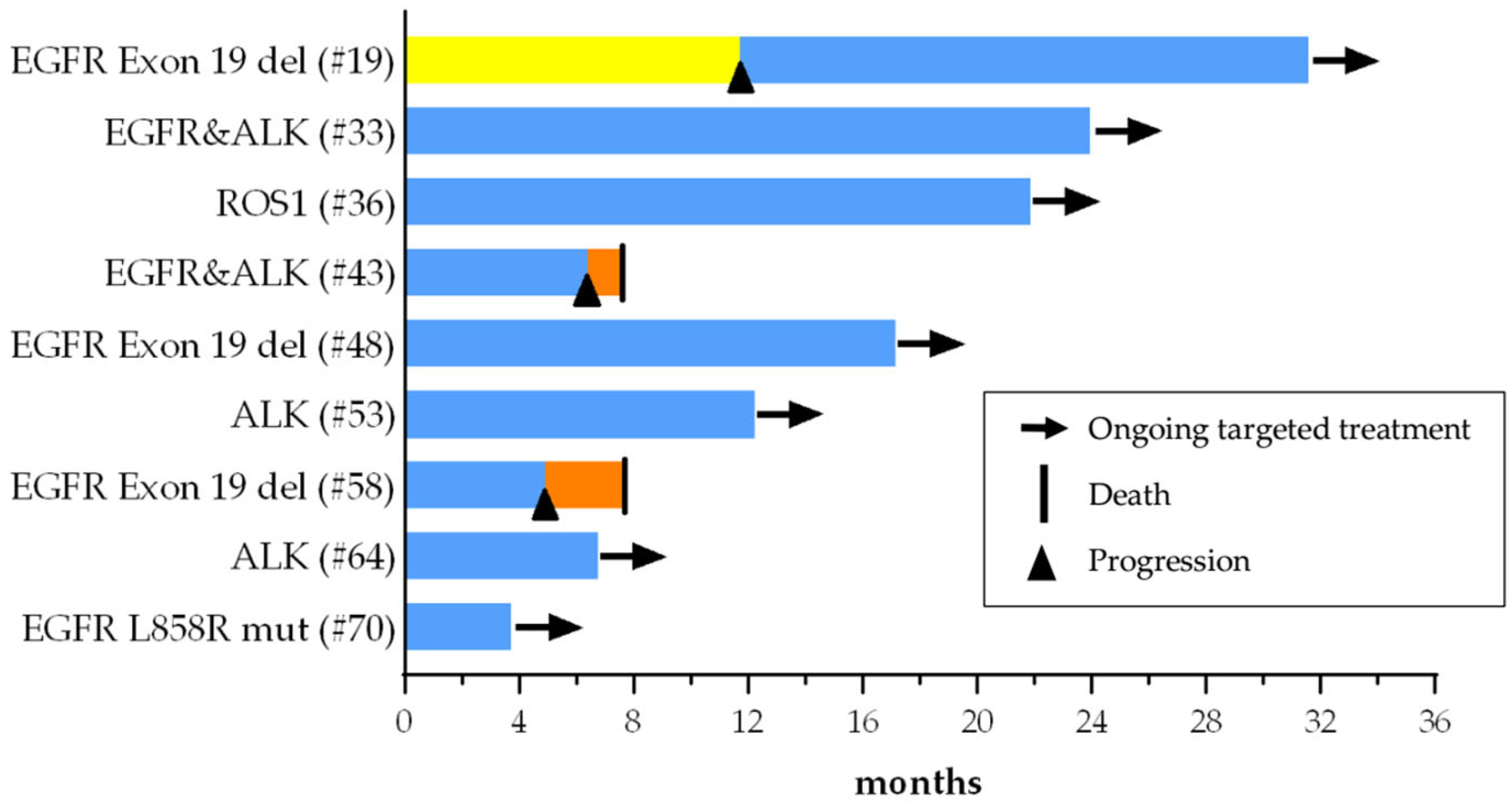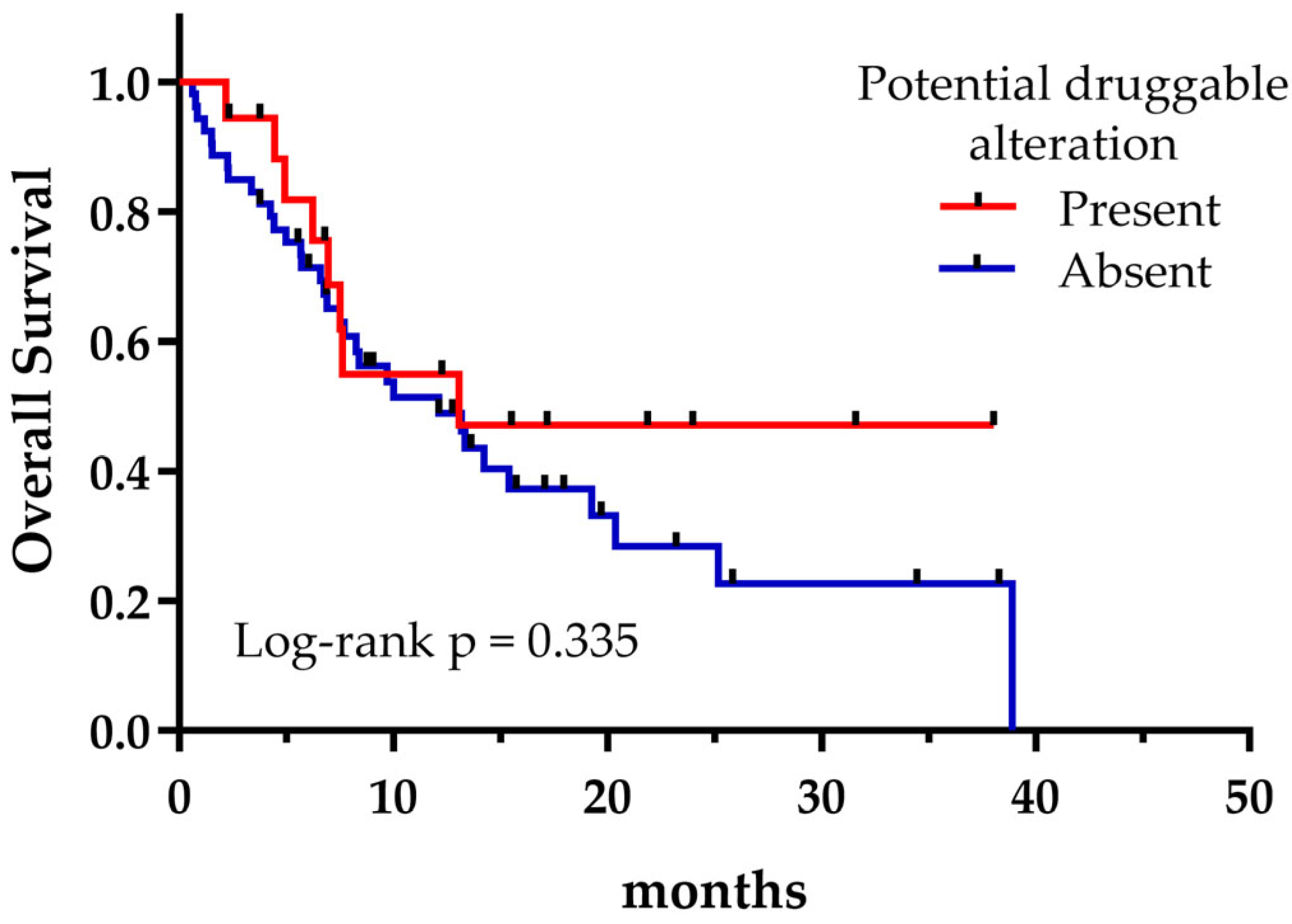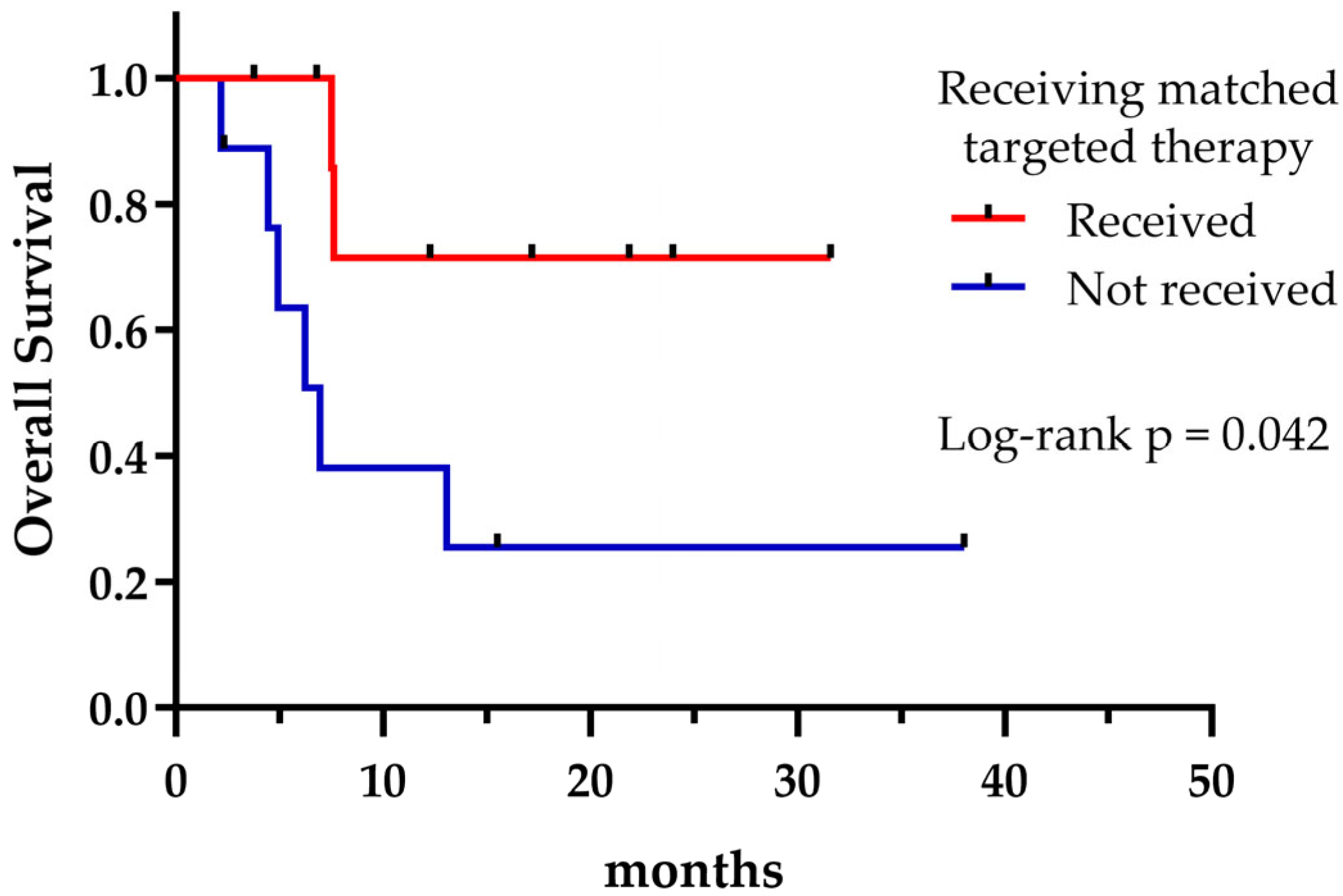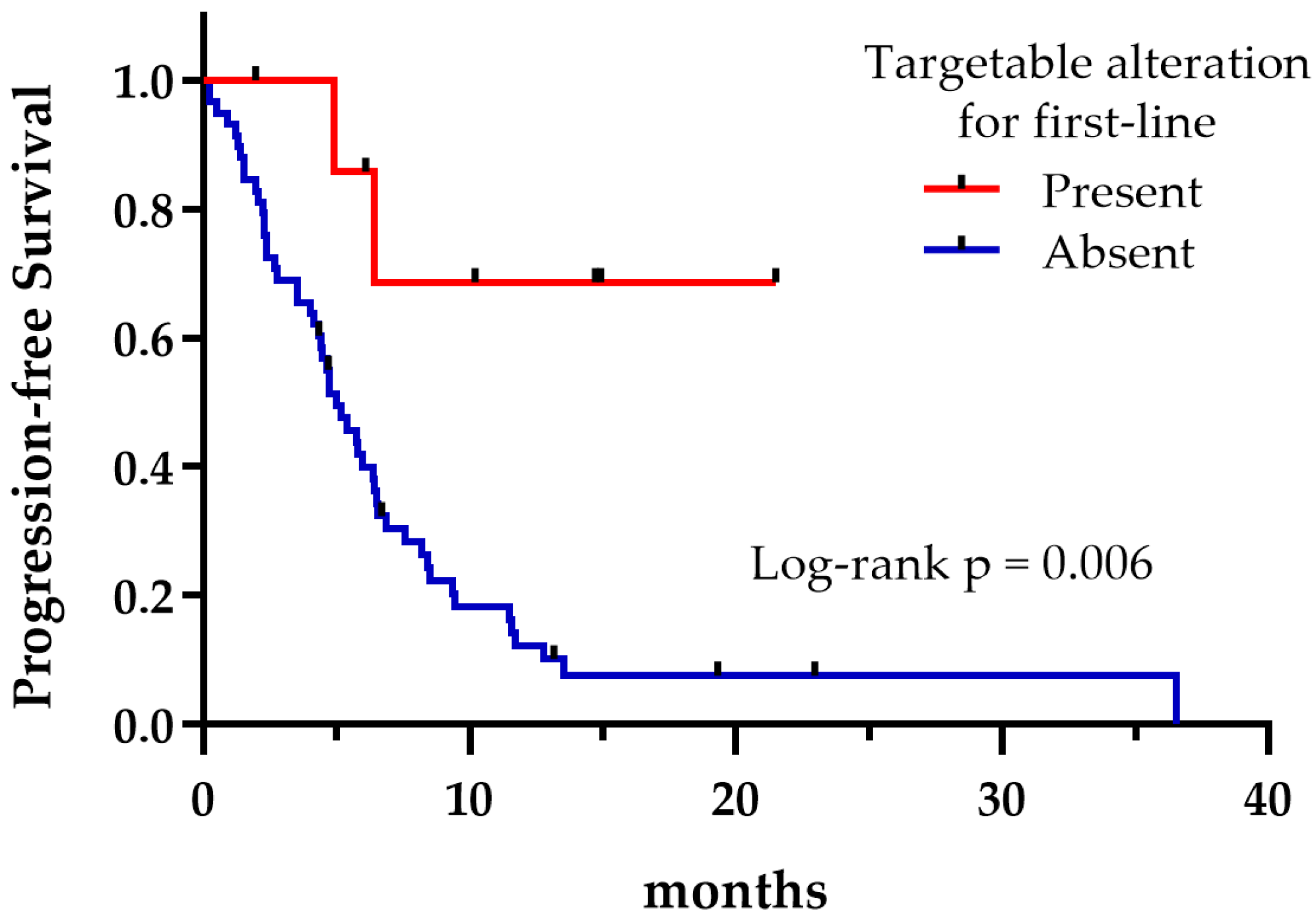Molecular Profiling in Non-Small-Cell Lung Cancer: A Single-Center Study on Prevalence and Prognosis
Abstract
1. Introduction
2. Materials and Methods
2.1. Study Design and Data Collection
2.2. Molecular Alterations
2.3. Nucleic Acid Extraction and Next-Generation Sequencing
2.4. Treatments
2.5. Statistical Analysis
3. Results
3.1. Baseline Patient Characteristics
3.2. Molecular Profile of the Patients
3.3. Relationships Between Clinicopathological Features and Alterations
3.4. Targetable Alterations
3.5. First-Line Treatments
3.6. Impact of Targetable Alterations on Survival
4. Discussion
5. Conclusions
Author Contributions
Funding
Institutional Review Board Statement
Informed Consent Statement
Data Availability Statement
Conflicts of Interest
References
- Li, M.S.C.; Mok, K.K.S.; Mok, T.S.K. Developments in targeted therapy & immunotherapy—How non-small cell lung cancer management will change in the next decade: A narrative review. Ann. Transl. Med. 2023, 11, 358. [Google Scholar]
- Tan, A.C.; Tan, D.S.W. Targeted Therapies for Lung Cancer Patients with Oncogenic Driver Molecular Alterations. J. Clin. Oncol. 2022, 40, 611–625. [Google Scholar] [CrossRef]
- Riely, G.J.; Wood, D.E.; Ettinger, D.S.; Aisner, D.L.; Akerley, W.; Bauman, J.R.; Bharat, A.; Bruno, D.S.; Chang, J.Y.; Chirieac, L.R.; et al. Non-Small Cell Lung Cancer, Version 4.2024, NCCN Clinical Practice Guidelines in Oncology. J. Natl. Compr. Cancer Netw. 2024, 22, 249–274. [Google Scholar] [CrossRef]
- Hendriks, L.E.; Kerr, K.M.; Menis, J.; Mok, T.S.; Nestle, U.; Passaro, A.; Peters, S.; Planchard, D.; Smit, E.F.; Solomon, B.J.; et al. Oncogene-addicted metastatic non-small-cell lung cancer: ESMO Clinical Practice Guideline for diagnosis, treatment and follow-up. Ann. Oncol. 2023, 34, 339–357. [Google Scholar] [CrossRef]
- El-Deiry, W.S.; Goldberg, R.M.; Lenz, H.-J.; Shields, A.F.; Gibney, G.T.; Tan, A.R.; Brown, J.; Eisenberg, B.; Heath, E.I.; Phuphanich, S.; et al. The current state of molecular testing in the treatment of patients with solid tumors, 2019. CA Cancer J. Clin. 2019, 69, 305–343. [Google Scholar] [CrossRef]
- Moorcraft, S.Y.; Gonzalez, D.; Walker, B.A. Understanding next generation sequencing in oncology: A guide for oncologists. Crit. Rev. Oncol./Hematol. 2015, 96, 463–474. [Google Scholar] [CrossRef]
- Lazzari, C.; Bulotta, A.; Cangi, M.G.; Bucci, G.; Pecciarini, L.; Bonfiglio, S.; Lorusso, V.; Ippati, S.; Arrigoni, G.; Grassini, G.; et al. Next Generation Sequencing in Non-Small Cell Lung Cancer: Pitfalls and Opportunities. Diagnostics 2020, 10, 1092. [Google Scholar] [CrossRef]
- Tsao, M.S.; Yatabe, Y. Old Soldiers Never Die: Is There Still a Role for Immunohistochemistry in the Era of Next-Generation Sequencing Panel Testing? J. Thorac. Oncol. 2019, 14, 2035–2038. [Google Scholar] [CrossRef]
- Laes, J.-F.; Aftimos, P.; Barthelemy, P.; Bellmunt, J.; Berchem, G.; Camps, C.; de Las Peñas, R.; Finzel, A.; García-Foncillas, J.; Hervonen, P. The clinical impact of using complex molecular profiling strategies in routine oncology practice. Oncotarget 2018, 9, 20282. [Google Scholar] [CrossRef]
- Pecciarini, L.; Brunetto, E.; Grassini, G.; De Pascali, V.; Ogliari, F.R.; Talarico, A.; Marra, G.; Magliacane, G.; Redegalli, M.; Arrigoni, G.; et al. Gene Fusion Detection in NSCLC Routine Clinical Practice: Targeted-NGS or FISH? Cells 2023, 12, 1135. [Google Scholar] [CrossRef]
- Smeltzer, M.P.; Wynes, M.W.; Lantuejoul, S.; Soo, R.; Ramalingam, S.S.; Varella-Garcia, M.; Meadows Taylor, M.; Richeimer, K.; Wood, K.; Howell, K.E.; et al. The International Association for the Study of Lung Cancer Global Survey on Molecular Testing in Lung Cancer. J. Thorac. Oncol. 2020, 15, 1434–1448. [Google Scholar] [CrossRef]
- Bray, F.; Laversanne, M.; Sung, H.; Ferlay, J.; Siegel, R.L.; Soerjomataram, I.; Jemal, A. Global cancer statistics 2022: GLOBOCAN estimates of incidence and mortality worldwide for 36 cancers in 185 countries. CA Cancer J. Clin. 2024, 74, 229–263. [Google Scholar] [CrossRef]
- Cangır, A.K.; Yumuk, P.F.; Sak, S.D.; Akyürek, S.; Eralp, Y.; Yılmaz, Ü.; Selek, U.; Eroğlu, A.; Tatlı, A.M.; Dinçbaş, F.Ö.; et al. Lung Cancer in Turkey. J. Thorac. Oncol. 2022, 17, 1158–1170. [Google Scholar] [CrossRef]
- Pennell, N.A.; Arcila, M.E.; Gandara, D.R.; West, H. Biomarker Testing for Patients with Advanced Non-Small Cell Lung Cancer: Real-World Issues and Tough Choices. In American Society of Clinical Oncology Educational Book; American Society of Clinical Oncology: Alexandria, VA, USA, 2019; pp. 531–542. [Google Scholar] [CrossRef]
- Ferreira-Gonzalez, A.; Ko, G.; Fusco, N.; Stewart, F.; Kistler, K.; Appukkuttan, S.; Hocum, B.; Allen, S.M.; Babajanyan, S. Barriers and facilitators to next-generation sequencing use in United States oncology settings: A systematic review. Future Oncol. 2024, 20, 2765–2777. [Google Scholar] [CrossRef]
- Kızılırmak, D.; Yılmaz Kaya, Z.; Gökçimen, G.; Havlucu, Y.; Cengiz Özyurt, B.; Gündoğuş, B.; Esendağlı, D.; Serez Kaya, B.; Yılmam, İ.; Aydemir, Y.; et al. Lung cancer from suspicion to treatment: An indicator of healthcare access in Turkey. Cancer Epidemiol. 2023, 87, 102480. [Google Scholar] [CrossRef]
- Zahed, H.; Feng, X.; Sheikh, M.; Bray, F.; Ferlay, J.; Ginsburg, O.; Shiels, M.S.; Robbins, H.A. Age at diagnosis for lung, colon, breast and prostate cancers: An international comparative study. Int. J. Cancer 2024, 154, 28–40. [Google Scholar] [CrossRef]
- Demiray, A.; Yaren, A.; Karagenç, N.; Bir, F.; Demiray, A.G.; Er, K.; Tokgün, O.; Elmas, L.; Akça, H. The Frequency of EGFR and KRAS Mutations in the Turkish Population with Non-small Cell Lung Cancer and their Response to Erlotinib Therapy. Balk. J. Med. Genet. 2018, 21, 21–26. [Google Scholar] [CrossRef]
- Özçelik, N.; Aksel, N.; Bülbül, Y.; Erdoğan, Y.; Güldaval, F.; Gül, Ş.K.; Bircan, A.; Can, A.; Öz, N.; Şentürk, A. Regional distribution of genetic mutation in lung cancer in Turkey (REDIGMA). Tuberk Toraks 2019, 67, 197–204. [Google Scholar] [CrossRef]
- Chapman, A.M.; Sun, K.Y.; Ruestow, P.; Cowan, D.M.; Madl, A.K. Lung cancer mutation profile of EGFR, ALK, and KRAS: Meta-analysis and comparison of never and ever smokers. Lung Cancer 2016, 102, 122–134. [Google Scholar] [CrossRef]
- Zhang, Y.-L.; Yuan, J.-Q.; Wang, K.-F.; Fu, X.-H.; Han, X.-R.; Threapleton, D.; Yang, Z.-Y.; Mao, C.; Tang, J.-L. The prevalence of EGFR mutation in patients with non-small cell lung cancer: A systematic review and meta-analysis. Oncotarget 2016, 7, 78985. [Google Scholar] [CrossRef]
- Zhu, Q.; Zhan, P.; Zhang, X.; Lv, T.; Song, Y. Clinicopathologic characteristics of patients with ROS1 fusion gene in non-small cell lung cancer: A meta-analysis. Transl. Lung Cancer Res. 2015, 4, 300–309. [Google Scholar]
- Tsoulos, N.; Papadopoulou, E.; Metaxa-Mariatou, V.; Tsaousis, G.; Efstathiadou, C.; Tounta, G.; Scapeti, A.; Bourkoula, E.; Zarogoulidis, P.; Pentheroudakis, G.; et al. Tumor molecular profiling of NSCLC patients using next generation sequencing. Oncol. Rep. 2017, 38, 3419–3429. [Google Scholar] [CrossRef][Green Version]
- Simarro, J.; Pérez-Simó, G.; Mancheño, N.; Ansotegui, E.; Muñoz-Núñez, C.F.; Gómez-Codina, J.; Juan, Ó.; Palanca, S. Impact of Molecular Testing Using Next-Generation Sequencing in the Clinical Management of Patients with Non-Small Cell Lung Cancer in a Public Healthcare Hospital. Cancers 2023, 15, 1705. [Google Scholar] [CrossRef]
- Kuang, S.; Fung, A.S.; Perdrizet, K.A.; Chen, K.; Li, J.J.N.; Le, L.W.; Cabanero, M.; Karsaneh, O.A.A.; Tsao, M.S.; Morganstein, J.; et al. Upfront Next Generation Sequencing in Non-Small Cell Lung Cancer. Curr. Oncol. 2022, 29, 4428–4437. [Google Scholar] [CrossRef]
- Izumi, M.; Suzumura, T.; Ogawa, K.; Matsumoto, Y.; Sawa, K.; Yoshimoto, N.; Tani, Y.; Watanabe, T.; Kaneda, H.; Mitsuoka, S.; et al. Differences in molecular epidemiology of lung cancer among ethnicities (Asian vs. Caucasian). J. Thorac. Dis. 2019, 12, 3776–3784. [Google Scholar] [CrossRef]
- Eser, M.; Hekimoglu, G.; Yarar, M.H.; Canbek, S.; Ozcelik, M. KRAS G12C mutation in NSCLC in a small genetic center: Insights into sotorasib therapy response potential. Sci. Rep. 2024, 14, 26581. [Google Scholar] [CrossRef]
- Karachaliou, A.; Kotteas, E.; Fiste, O.; Syrigos, K. Emerging Therapies in Kirsten Rat Sarcoma Virus (+) Non-Small-Cell Lung Cancer. Cancers 2024, 16, 1447. [Google Scholar] [CrossRef]
- Kahraman Çetin, N.; Erdoğdu, İ.H.; Bozkurt, E.; Meteoğlu, İ. Evaluation of the Mutation Profile via Next-Generation Sequencing in a Turkish Population with Non-small Cell Lung Cancer. Balk. Med. J. 2021, 38, 382–391. [Google Scholar] [CrossRef]
- Fois, S.S.; Paliogiannis, P.; Zinellu, A.; Fois, A.G.; Cossu, A.; Palmieri, G. Molecular Epidemiology of the Main Druggable Genetic Alterations in Non-Small Cell Lung Cancer. Int. J. Mol. Sci. 2021, 22, 612. [Google Scholar] [CrossRef]
- Lin, J.J.; Riely, G.J.; Shaw, A.T. Targeting ALK: Precision Medicine Takes on Drug Resistance. Cancer Discov. 2017, 7, 137–155. [Google Scholar] [CrossRef]
- Kim, J.H.; Yoon, S.; Lee, D.H.; Jang, S.J.; Chun, S.-M.; Kim, S.-W. Real-world utility of next-generation sequencing for targeted gene analysis and its application to treatment in lung adenocarcinoma. Cancer Med. 2021, 10, 3197–3204. [Google Scholar] [CrossRef] [PubMed]
- Shah, M.; Noronha, V.; Patil, V.; Singh, A.K.; Menon, N.; Goud, S.; Shah, S.; More, S.; Kapoor, A.; Mishra, B.K.; et al. Genomic Profiling of Driver Gene Alterations in Patients with Non-Small Cell Lung Cancer, Patterns of Treatment and Impact on Survival Outcomes: A Single Center Experience of More Than 1200 Patients. Clin. Lung Cancer 2025, in press. [CrossRef]
- Porta, C.; Pradelli, L.; Sicari, E.; Castellani, S.; Sivakumar, S.; Sokol, E.; Montesion, M.; Wieland, T.; Rambichler, J.; Minari, R. Liquid biopsy comprehensive genomic profiling of lung cancer in the Italian population: A real-world experience. Lung Cancer 2023, 185, 107359. [Google Scholar] [CrossRef] [PubMed]
- Gün, E.; Çakır, İ.E.; Ersöz, H.; Oflazoğlu, U.; Sertoğullarından, B. The Epidermal Growth Factor, Anaplastic Lymphoma Kinase, and ROS Proto-oncogene 1 Mutation Profile of Non-Small Cell Lung Carcinomas in the Turkish Population: A Single-Center Analysis. Thorac. Res. Pract. 2024, 25, 102. [Google Scholar] [CrossRef]
- Bhandari, N.R.; Hess, L.M.; He, D.; Peterson, P. Biomarker Testing, Treatment, and Outcomes in Patients With Advanced/Metastatic Non-Small Cell Lung Cancer Using a Real-World Database. J. Natl. Compr. Cancer Netw. 2023, 21, 934–944.e931. [Google Scholar] [CrossRef]
- Guaitoli, G.; Tiseo, M.; Di Maio, M.; Friboulet, L.; Facchinetti, F. Immune checkpoint inhibitors in oncogene-addicted non-small cell lung cancer: A systematic review and meta-analysis. Transl. Lung Cancer Res. 2021, 10, 2890–2916. [Google Scholar] [CrossRef]






| Variables | |
|---|---|
| Median age, years (range) | 65 (43–78) |
| Gender, n (%) | |
| Female | 16 (22.9) |
| Male | 54 (77.1) |
| Smoking status, n (%) | |
| Never | 15 (21.4) |
| Active or former | 55 (78.6) |
| Smoking pack/years, median (IQR) | 40 (31) |
| Histology, n (%) | |
| Adenocarcinoma | 44 (62.9) |
| Squamous | 22 (31.4) |
| Large-cell | 4 (5.7) |
| PD-L1 TPS, n (%) | |
| <1% | 35 (50) |
| ≥1% | 35 (50) |
| Number of metastatic sites, n (%) | |
| 1 | 33 (47.1) |
| 2 | 25 (35.7) |
| ≥3 | 12 (17.2) |
| Liver metastasis, n (%) | |
| Yes | 10 (14.3) |
| No | 60 (85.7) |
| Bone metastasis, n (%) | |
| Yes | 32 (45.7) |
| No | 38 (54.3) |
| CNS metastasis, n (%) | |
| Yes | 17 (24.3) |
| No | 53 (75.7) |
| Alteration | n (%) |
|---|---|
| BRAF | 2 (2.9) |
| KEAP1 | 2 (2.9) |
| ATM | 2 (2.9) |
| PTEN | 2 (2.9) |
| NOTCH4 | 2 (2.9) |
| SETD2 | 2 (2.9) |
| TSC1 | 2 (2.9) |
| ROS1 | 1 (1.4) |
| AKT1 | 1 (1.4) |
| ARID1A | 1 (1.4) |
| BRCA1-2 | 1 (1.4) |
| MAP2K1 | 1 (1.4) |
| SMARCA4 | 1 (1.4) |
| FGFR1 | 1 (1.4) |
Disclaimer/Publisher’s Note: The statements, opinions and data contained in all publications are solely those of the individual author(s) and contributor(s) and not of MDPI and/or the editor(s). MDPI and/or the editor(s) disclaim responsibility for any injury to people or property resulting from any ideas, methods, instructions or products referred to in the content. |
© 2025 by the authors. Licensee MDPI, Basel, Switzerland. This article is an open access article distributed under the terms and conditions of the Creative Commons Attribution (CC BY) license (https://creativecommons.org/licenses/by/4.0/).
Share and Cite
Arıcı, M.Ö.; Demirkan, B.; Taştekin, E.; Kıvrak Salim, D. Molecular Profiling in Non-Small-Cell Lung Cancer: A Single-Center Study on Prevalence and Prognosis. Curr. Oncol. 2025, 32, 274. https://doi.org/10.3390/curroncol32050274
Arıcı MÖ, Demirkan B, Taştekin E, Kıvrak Salim D. Molecular Profiling in Non-Small-Cell Lung Cancer: A Single-Center Study on Prevalence and Prognosis. Current Oncology. 2025; 32(5):274. https://doi.org/10.3390/curroncol32050274
Chicago/Turabian StyleArıcı, Mustafa Özgür, Bora Demirkan, Ebru Taştekin, and Derya Kıvrak Salim. 2025. "Molecular Profiling in Non-Small-Cell Lung Cancer: A Single-Center Study on Prevalence and Prognosis" Current Oncology 32, no. 5: 274. https://doi.org/10.3390/curroncol32050274
APA StyleArıcı, M. Ö., Demirkan, B., Taştekin, E., & Kıvrak Salim, D. (2025). Molecular Profiling in Non-Small-Cell Lung Cancer: A Single-Center Study on Prevalence and Prognosis. Current Oncology, 32(5), 274. https://doi.org/10.3390/curroncol32050274





